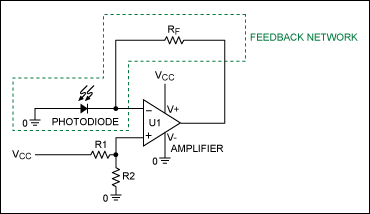I am designing a trans-impedance amplifier using a TEMD7000X01 photodiode and an AD8551ARZ op-amp. RF is 100 kΩ, CF is 150 pF, and VCC is +3.3 V. The output of the op-amp is connected to an ADC pin of a microcontroller.
This circuit works as intended when the op-amp is on, but when it is off, because the diode is forward-biased, the voltage at the output is negative, which is an issue for our microcontroller. Adding a small signal diode at the output does help limit the negative voltage, but there is some leakage current which is not ideal.
I had thought that if the photodiode was reverse-biased instead, it would fix the negative voltage issue when the op-amp is off. This does fix the negative voltage issue when the op-amp is off, but when it is on, the output is stuck at 0. Any advice on how to manipulate the circuit to fix the negative voltage issue?


